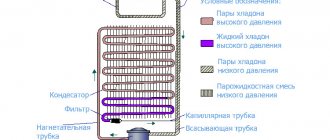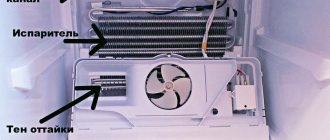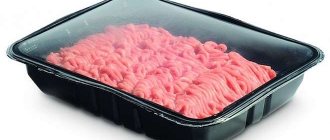Principle of operation
Take a look at this infographic. Here we tried to visualize everything we know about these defrosting systems.
Drip system
The first and more common is the drip system or, as it is also called, “crying”.
The principle of operation of this system is to locate a special evaporator behind the rear wall of the refrigeration chamber. This device distributes cooling along this wall, as a result of which condensation forms on its surface - droplets of water, which slowly flow into a special container.
It is because of this phenomenon that such refrigerators are called “crying.”
Note that in this case, the side panels and other surfaces of the chamber remain dry, and when the compressor is active, the condensate freezes, forming small pieces of ice.
No frost system - what is it?
The No Frost technology (from the English No frost - “no frost”) has a slightly different operating principle, which is as follows.
Cooling of the refrigerator and freezer compartments is also carried out using a compressor and evaporator, which is located in the rear compartment of the refrigerator.
In this case, the low temperature is distributed throughout the chambers using hidden fans that ensure constant air circulation.
In such refrigerators, condensation also releases and freezes on the back wall, but it is significantly less than in a drip system.
In simple words: in such a refrigerator a fan is constantly running, which evenly distributes the cold throughout the chamber.
This video clearly and clearly shows the process of operation of a refrigerator with the No frost system:
And here is also one of the reviews about this technology:
If you need more information on the technical part of refrigerators, we recommend that you refer to the Wikipedia article.
Compressor type: inverter or conventional
To understand which refrigerator to choose - with a conventional or inverter compressor - you need to understand how they differ.
One of the tasks is to choose the type of refrigerator compressor
Conventional compressor
How does a refrigerator with a conventional compressor work? The temperature you set is controlled by a sensor. When it drops by 1-2 degrees, the sensor sends a signal to turn on, the relay is activated, and the compressor turns on. It works until the temperature drops by the same 1-2 degrees. Then the cycle repeats.
In refrigerators with a conventional compressor, the temperature varies in the range of plus or minus two to four degrees, the compressor always operates at full power. Moreover, when it is turned on, overloads occur - starting currents are several times higher than operating currents. This overloads the system and interferes with the operation of power-sensitive equipment. In addition, these frequent starts lead to high energy consumption and shorten the operating life of the unit itself.
Types of compressors in modern refrigerators, their main properties
Inverter
This is not how an inverter compressor works. It has a power change system. Immediately after switching on, until the temperature rises, it operates at maximum speed. As the temperature approaches the set point, its power gradually decreases. Then it operates at low speeds - only to maintain the set mode. During operation, the power increases only after the refrigerator is opened/closed and a new portion of food is added, causing the temperature to rise. But at maximum they no longer work - there is no need.
So, in refrigerators with inverter compressors, the temperature is maintained stably, with minimal deviations. Inrush currents occur very rarely - after turning off the power and defrosting. The compressor operates constantly, but in a gentle mode, which extends its service life and reduces energy consumption. Most models with high energy efficiency have an inverter compressor.
Compressor type affects energy consumption and noise levels
There is another type of inverter compressor - linear and inverter. In addition to all the advantages described above, there is a very low noise level and a low degree of wear. If you want to choose the quietest refrigerator, look for ones with linear inverter compressors. For example, LG GA M589ZMQZ with a linear inverter cooler at its highest power produces a noise of 40 dB. This is what a person whispers like. Although, this is far from the only refrigerator with such a noise level: LIEBHERR CTP 2521, Bomann KG 211, NORD DRF 200, GORENJE RKI4182E1, BEKO RCSK339M20 W, Indesit TIA 140 and many more models. There are even quieter ones - producing from 23 to 37 dB, but their prices are very high - about $3000.
The disadvantage of refrigerators with an inverter compressor (any) is their price. They are twice as expensive as models with similar parameters, but with a conventional cooler. Another disadvantage is that they are demanding on the quality of power supply. Therefore, when buying a refrigerator with an inverter compressor, take care of a voltage stabilizer. Despite all the minutes, if possible, it is better to take inverter models.
Now you know how to choose a refrigerator based on the main technical parameters. This was the hardest part. It remains to deal with simple things.
comparison table
In order to clearly analyze and compare the advantages and disadvantages of each automatic defrosting system, we have compiled a summary table.
| Drip (crying) system | |
| pros | Minuses |
|
|
| "No frost" system | |
| pros | Minuses |
|
|
Operation of freezers with a drip system
Such freezers are installed outside the ultraviolet radiation zone, ensuring the accessibility of ventilation holes. Storage and freezing rules are standard.
It is necessary to remove frost with a plastic scraper, which will not damage the coating of the chambers. A car brush with a spatula is suitable for this purpose to remove ice from the windshield. A thicker layer of frost requires careful manual defrosting according to the instructions.
The temperature control inside the chambers is adjusted based on the amount of food and the ambient temperature. For this purpose, there is a special regulator on the control panel. You can also use the storage and freezing modes.
Myths about “No frost”
Among buyers, especially potential ones, i.e. For those who actually do not have a No Frost refrigerator, several rumors and tales have been circulated regarding the operation of this system.
Let's look at them and try to debunk them or admit them.
- 1 Harmful - they say that No Frost works on some special type of freon, which is harmful to health.
This is pure fiction!Refrigerators of this system use the same compressors and refrigerants as drip ones. For example, here is one of the many reviews on this matter:
- 2 Dries food - this is partly true, but also partly a myth. The fact is that air circulation through the refrigerator compartment can slightly accelerate the oxidation process of cut vegetables, fruits, and bread.
In this regard, it is recommended to pack chopped pieces or half-eaten fruits into food containers or cover them with film. Whole apples, berries, tomatoes, etc. on the contrary, they are stored an order of magnitude longer than in their drip counterparts.For example, take a look at this helpful review:
- 3 No Frost does not need to be defrosted - this is not entirely true.
Like the drip system, No frost forms a small amount of condensation on the back wall, which freezes. Yes, in the operating manuals of some models of No frost cameras, they actually write that the refrigerator does not need to be defrosted at all.But in practice, you need to turn off the refrigerator at least once a year just to wash it.
After all, over a long period of operation, for example, various traces of food, stains or other contaminants can accumulate in the refrigerator compartment.
Thus, “defrosting” No Frost involves simply washing the refrigerator for hygienic and sanitary reasons. It’s the same story with the drip system, only with greater regularity of care.
Although some housewives do not quite adhere to this rule:
- 4No frost refrigerators have less space than drip refrigerators.
This is not a myth, it really is. Therefore, it is recommended to carefully look at such a parameter as the volume of chambers before purchasing. In general, with a competent approach to arranging food, this nuance will not be critical for most housewives.
Next myth.
Refrigerator care
In order for the device to serve for a long time and perform its job properly, you need to know the following rules:
- During transportation, it is important not to tilt the device below 40 degrees. Otherwise, the oil liquid in the refrigerator motor will leak out and fill the refrigerant compartment. As a result, the capillary will become clogged, which may lead to unscheduled repairs. If the device can only be carried horizontally, you must make sure that the compressor tube is directed upward .
- It is not recommended to install the device in direct sunlight or near a radiator, stove or other heating elements. When heated, the components of the device are destroyed, and the enamel of the case may also deteriorate. The distance to heating devices must be at least 50 cm. When installing the “Warm Floor” system for the refrigerator, it is necessary to provide a place that will not heat up.
- When placing the refrigerator, it is advisable to leave an additional distance - 5 cm on each edge . It is not advisable to press the appliance against walls and cabinets, since the larger the space, the easier the compressor operates, which lightens the overall load on the operation of the refrigerator.
- It is necessary to maintain cleanliness in the cells - remove dirt and disinfect. You need to wash the device 2-3 times a year using a special composition and a soft sponge. The back wall also needs to be cleaned. It is important to remove accumulated dust, which shortens the life of the refrigerator and increases energy consumption.
Do not wash the back wall of the drip refrigerator while connected to the network. Before wet cleaning, be sure to make sure that the device is de-energized.
Before carrying out wet cleaning, the refrigerator must be de-energized.
Caring for your drip refrigerator
A drip-type refrigerator needs to be thawed 2 times a month. Do not chip off frozen ice with sharp utensils - this could damage the evaporator.
Experts recommend controlling the humidity inside the chambers, since it negatively affects the coating of the walls and also becomes the key to an unpleasant odor. To avoid moisture, follow these simple guidelines:
- close containers with liquids (soups, drinks), as well as fruits and vegetables;
- Clean the drain channel regularly;
- do not place hot foods in the chambers;
- do not open compartment doors unless necessary;
- The thermostat level is directly set depending on the number of products in the chambers - there is no need to lower the temperature if there are few products in the compartment.
Compliance with these rules will allow you to preserve the operation of an important household appliance for a long time.
It is recommended to store food in the refrigerator in closed containers
Caring for the No Frost refrigerator
Despite the declared independence during defrosting, No Frost appliances also need to be looked after. With this type, defrosting occurs unnoticed by the owner, but it is still necessary to wash off the accumulated condensate from the walls.
Sometimes a thin layer of frost can be seen on the evaporator wall. This is possible if the integrity of the rubber seal is damaged. In this case, air penetrates into the chambers of the device, heats up in the compartment, and liquid is produced, which settles on the surfaces and turns into ice.
Once every six months, it is necessary to unplug the device and defrost it for 12–24 hours, and also wipe all the walls inside and outside the refrigerator. After this, the device should dry for an hour. It is not recommended to immediately after harvesting put food into the chambers and turn on the refrigerator, since the temperature should drop quickly. This puts a serious load on the engine of the device.
Care products
The above remedies are equally useful for all devices, regardless of the defrosting method. The main thing to remember is that when cleaning the surfaces of the refrigerator, you should not use hard brushes or products with abrasive particles, as this can damage the surface of the chamber.
Baking soda has proven itself especially well, since it is ideal for treating the internal surfaces of chambers, since for these purposes it is not recommended to use chemical and soap-based products (soap, dishwashing liquid, etc.). Baking soda is famous for its properties of eliminating unpleasant odors in refrigerator compartments. To prepare the solution you will need to mix 1 tbsp. spoon of soda with 1 liter of warm water.
You can treat the interior surfaces of the refrigerator with baking soda.
In addition, lemon juice is used to remove dirt, and ammonia is used to fight fungus and bacteria. A soap solution is suitable for treating seals and the outer walls of the refrigerator. It must be diluted carefully to avoid the formation of a large amount of foam.
Ammonia destroys fungus and bacteria
After treating the surfaces of the chambers with soap or soda solution, it is necessary to rinse it off with warm water.
The modern market offers many products for the care of refrigeration equipment, which are divided into two groups:
- to eliminate odors;
- for disinfection.
When choosing products from the first group, it is worth remembering that odor absorption is carried out due to activated carbon, which is part of the solution. Some products work on the principle of deodorant - they can only mask the unpleasant odor with aromatic fragrances. The products of the second group are harmless to human health and the camera coating, and do not have aromatic substances.
It is also worth noting that the internal accessories of the cameras also need to be cleaned. Therefore, do not forget to wash the shelves and drawers and then dry them thoroughly.
Photo gallery: special products for cleaning refrigerators
Selena refrigerator cleaner has antibacterial properties
Unicum detergent for washing built-in appliances and refrigerators removes unpleasant odors Unicum detergent for cleaning kitchen appliances and adding shine, also suitable for refrigerators
Low Frost technology
Now let's look at another defrosting system in the refrigerator - “Low frost” and find out what it is. Let’s say right away that it differs from “know frost”. This technology appeared relatively recently, it is less than 15 years old. It was developed by the German company Bosch, which successfully uses it in its modern refrigerators.
Over time, “low frost” appeared in models from other manufacturers (AEG, Siemens, Gorenje).
The essence of Low Frost:
- the evaporator circuit is located along the entire outer perimeter of the chamber;
- this results in more uniform cooling and temperature distribution;
- minimal ice formation (from practice, in the form of a very thin ice coating on the walls and shelves);
- very fast defrosting and easy defrosting;
- Applies only to freezer compartments.
As you can see, a Low Frost refrigerator with freezer also needs to be defrosted, but quite rarely. For example, Bosch recommends defrosting once a year.
That is, as in the case of No frost, in fact, defrosting such a chamber is necessary primarily for sanitary reasons. If you handle your freezer very carefully (or don’t use it at all), then you can defrost it once every 5 years.
Additional features and functionality
Manufacturers can't come up with anything - refrigerators even come with a built-in TV. But besides exotic models with their unique bells and whistles, there are some very useful ones. If you have the opportunity to pay extra for comfort and ease of use... So here are the additional features a refrigerator may have:
- Super cooling freezer. A mode that is used when bulk loading products for freezing. Or if their temperature is high (in the summer, in the heat). The compressor turns on at full power to quickly reduce the temperature to +2°C. After it goes into normal operation.
- Super freezing of the refrigerator compartment. A similar mode, only the temperature is brought to -24°C.
- Antibacterial coating of the refrigerator compartment. The coating contains silver ions, which prevent the development of mold and pathogenic bacteria.
- Wine cabinet. A chamber with shelves for bottles and a special microclimate.
- Ice maker. There are two options - with a connection to a water supply or with a water tank.
Additional capabilities of refrigerators are becoming wider
- Chilled water supply. Water is poured into a special reservoir in the refrigerator. Its temperature is maintained constantly, and through special tubes it is supplied to the recess on the outside of the door.
- Electronic control. Allows you to more accurately set operating modes and control the processes taking place in the refrigerator. The refrigerator status is displayed on a digital display.
- Temperature indicator. Helps control the temperature in the refrigerator compartments.
- Door open indication. If the refrigerator door remains open for a long time, a light or sound signal will sound.
- Reversible doors. In the standard version, the doors are made “right-handed”. In models with the possibility of reversing, they can open in the opposite direction.
For now, these are all the functions that can be found in commercially produced refrigerators.











